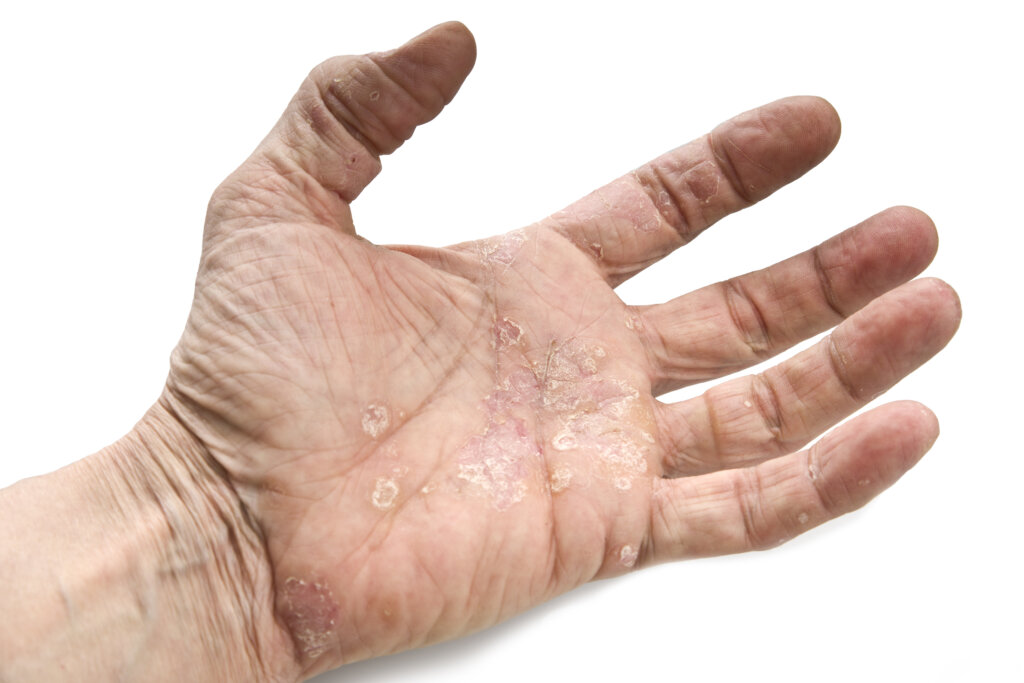PALMOPLANTAR PSORIASIS AND PALMOPLANTAR PUSTULOSIS
PALMOPLANTAR PSORIASIS
Palmoplantar Psoriasis is a chronic, persistent condition that generally affects the hands and feet. The name derives from the word Palmo, meaning palm of the hand, and plantar, meaning sole of the foot. It is quite difficult to treat and can become very debilitating and disabling. As with other psoriasis symptoms, hand and foot psoriasis is caused mostly from the autoimmune response in which white blood cells are triggered within the body by mistake which, in turn, reduces the lifespan of the skin cells. The psoriasis symptoms that affect the palms and the soles of the feet generally take two forms:
Scaly plaques similar to a typical psoriasis found anywhere on the body or
what is knowns as Keratoderma which is more of a thickening and scaling.
Commonly associated with Psoriatic nail dystrophy and psoriatic arthritis, it will affect up to 25% of people who already suffer with chronic plaque psoriasis. For many people however, it will just affect the hands and feet and it can occur at any age.
Our hands and feet are sensitive and are generally more exposed to environmental and chemical triggers such as washing up, household work, manual labour, smoking etc. Exposures like this could play a large role in the development and progression of palmoplantar.
PALMOPLANTUR PUSTULITIS
When pustules occur on the hands or feet, this is often associated with a condition known as Palmoplantar Pustulosis. Like Palmoplantar it can occur at any age – usually between 20 and 60.
Palmoplantar Pustulosis is a fairly rare, chronic inflammatory skin condition which causes blisters filled with fluid to appear on the palms and soles of the feet. These blisters can be extremely painful. Whether or not PPP is actually a variation of psoriasis is still unclear, mostly due to some significant differences. It does happen to people who suffer from other types of psoriasis but it is not necessarily triggered by having psoriasis.
SYMPTOMS

When the palms and soles are affected by psoriasis, the symptoms tend to be large areas of clearly bordered red, dry and thickened skin. These areas often crack and bleed, creating fissures that are itchy and painful.
There may also be pitting and ridging on the nails – approximately 60% of people with palmoplantar will have this.
Small pustules on the skin – mostly associated with Palmoplantar Pustulosis
As an extraordinary feature, the patterns are often symmetrical in that they will look exactly the same on both hands (or both feet).
TRIGGERS

Manual work and repetitive trauma – PP is common amongst farmers and manual labourers.
Chemical irritants and detergents – PP is more evident in women than men at a ratio of 8:2 – this may be because women are more likely to be handling these chemicals for housework (sorry if that is sexist – but it seems to be the case).
Smoking – 95% of people with PP are either smokers or have smoked in the past. There is evidence to suggest that nicotine receptors in the sweat glands can create an inflammatory response which contributes to the process of this disease.
Cuts or abrasions – as with regular psoriasis, trauma or injury to the skin can trigger an autoimmune response in the body.
Stress
TREATMENT

As with all types of psoriasis, moisturising and continuous care of the hands and feet are essential. Wearing gloves for manual labour and housework, avoiding chemicals and detergents, keeping any cuts or abrasions clean and dry.
TOPICAL CREAMS
Dermatologists will most likely begin with steroid creams and possibly coal tar treatments. It is always worth trying natural, effective treatments like M-Folia that have active ingredients included in the formula to combat the symptoms of psoriasis as opposed to simple immolients and moisturisers.
Applying topical creams and then covering the skin with clingfilm has been shown to be effective at getting the treatment through the thickened skin.
PUVA
Palmoplantar and Palmoplantar Pustulosis can be stubborn to treat, and your dermatologist may recommend PUVA therapy using a small machine for your feet and hands as opposed to a large cabinet, where the soles are not reached by light.
DIET AND LIFESTYLE
More and more this is becoming the first, not the last, step to try for alleviating the symptoms of any type of psoriasis. For PP, smoking must stop completely and stress levels should be managed carefully. Cutting out red meat and alcohol is now very well documented to be of great benefit to psoriasis sufferers. Diet and nutrition are playing a larger role in determining health and managing symptoms. Look up books such as How To Treat Palmoplantar Pustulosis Naturally by Asa Karrman


